Month 12:8, Week 1:7 (Shibi'i/Sukkot), Year:Day 5945:332 AM
2Exodus 8/40
Gregorian Calendar: Monday 8 February 2022
Book of Revelation IX
The 7 Asian Assemblies - 3. Pergamum
(Revelation 2:12-17)
Second expanded edition, 12 February 2022
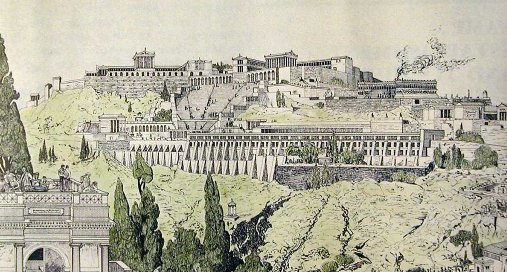
Continued from Part 9 (Book of Revelation)
Continued from Part 1 (Pergamum)
Introduction
Shabbat shalom kol beit Yisra'el and Mishpachah and welcome back to the ninth part on our study of the Book of Revelation.
Ephesus and Smyrna
We have now covered two of the seven congregations in depth, Ephesus and Smyrna, which were neighbouring cities and very prominent in their day, - the first because of the Temple of Artemis (Diana), a name we're hearing again with the new NASA moon programme that replaces Apollo, and the second because it was a rich commercial centre. As we saw last week, Smyrna is unique in two ways:
- 1. It continued to exist with the descendants of the original population until as late as 1922/3 before its brutal expulsion and continues to exist today as the Turkish city of İzmir; and
- 2. It, of all the seven congregations, was the only one Yah'shua (Jesus) found no fault with, yet warned they were about to go through 10 metaphorical 'days' of intense persecution, as history proved to be true.
3. THE CONGREGATION AT PERGAMOS/PERGAMUM/PERGAMON
Geographical Location
Continuing north from Ephesus and Smyrna we come to the inland city of Pergamum, the Latin form of the Greek Pergamos. This was the chief city of an area known as Mysia in the northwest part of Anatolia that is Asian Turkey today. It was about as far away from Smyrna (50 miles, 60 km) as Smyrna was from Ephesus and 15 miles (24 km) from the coast of the Aegean Sea. As a settlement it no longer exists and in that respect is as extinct as Ephesus. There is a nearby Turkish settlement called Bergama which is the Turkish name for Pergamum but it's in a slightly different location. Pergamum was originally a fortress on a steep, isolated hill between two rivers and in time, as the city grew, it spread down into the valley below, with the hill becoming an acropolis or citadel.
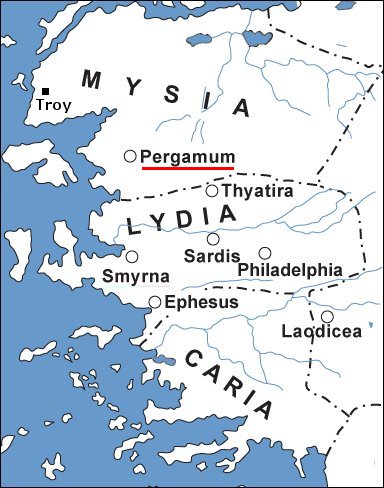
Historical Origins
Like Ephesus and Smyrna, this was originally a Greek settlement, colonists from Achaia in Greece, and by 420 BC is was minting its own coins. It's mentioned a century later by Xenophon as a fortified city. Maybe some of you have heard of an Oxford-based academic publishing house called Pergamon Press founded in 1948. The reason I know about this is because I once tried to get a job there as an editor before I found my vocation as a teacher. Why, you may wonder, did the book publisher choose to name itself after Pergamum/Pergamos? The answer is because ancient Pergamum once housed an immense library that was even bigger than the better known one in Alexandria, Egypt. Indeed, at one time it rivalled Alexandria, Antioch and Ephesus for culture and wealth. A special kind of writing parchment called charta Pergmena was invented here. In Nowegian and Swedish the word for 'parchment' is pergament and comes to our English language viâ the Latin pergamenum and the French parchemin. Pergamum was at one time its own kingdom that controlled most of western Asia Minor, so it too has a claim to fame. As a result, it was for a while the capital of the Roman Province of Asia until Ephesus was assigned the rôle. It enjoyed a long period of prosperity from the time Alexander in the 4th century BC until the 3rd. It was badly damaged by an earthquake in the middle of that century and sacked by the Goths not long after that. Nevertheless it continued to hold great prominence as an administrative centre and was later an obvious target for Christian/Messianic evangelism.
Another Pagan Religious Centre
To understand some of the perhaps curious things said in the Book of Revelation about the "seat of Satan" which always excites the pop theologians who have been led to all sorts of wild speculation (it's the only place in the Bible that mentions either the city or its 'seat'), we need to understand a little more about the pagan religious background of this place. Because I said last week and the week before that Ephesus was the 'religious' city because of its spectacular Temple of Artemis (Diana) and that by contrast Smyrna was the 'city of commerce' doesn't mean, of course, that Smyrna and all the other cities that were the locations of the seven congregations weren't highly religious too, because they were. The whole ancient world was saturated with pagan religion. And it was stressed no less in Pergamum than elsewhere.
An Altar to Zeus
Take the matter of the Chalean astrologers or magi who fled from Babylon to Pergamum, setting up their central college or 'seminary' there. Eumenes II built a massive marble altar there to the god Zeus to celebrate his defeat of the Gauls. Zeus was the chief Greek god as Jupiter was the Roman. It has since been dug up by archaeologists. It has a U-shaped platform about 166 feet (50 m) wide and 110 feet (33 m) deep. The stairway leading up to the altar is nearly 60 feet (18 m) wide and the base of the platform is decorated with an enormous relief called a Gigantomachy depicting gods at Olympus battling giants, the children of Gaia or Earth born from the blood shed by Uranus (the Sky) when he was castrated by their son, Kronos. That was, and still is, the seat of Satan, once centre piece of a pagan temple in Pergamum and now a relic in a German museum where it apparently is still having a destructive influence on that once great nation of poets, philosophers and musicians. The reassembly of Satan's Seat began in Berlin in 1930 toward the end of the Weimar Republicn and was completed under the Hitler régime.
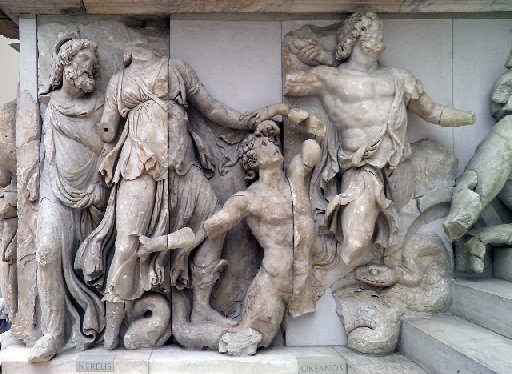 Part of the relief of the altar of Zeus in Pergamum
Part of the relief of the altar of Zeus in Pergamum
The Temple of Asclepius (Æsculapias)
But Pergamum wasn't only famous for its Altar to Zeus, the chief of the Greek pantheon. The sick from all parts of Asia Minor flocked to Pergamum because of its temple of Asclepius (Æsculapias), the Greek god of healing, medicine, well-being and health, whose symbol was, and remains, a serpent wrapped around a pole. The god Asclepius was known not only for his alleged healing and life-giving powers but for his attitude of benevolence for the people and these attributes made him one of the most popular and sought-out divinities in the Greco-Roman world. So Pergamum had a healing centre or temple - an asclepeion - much as we today have Health Centres in almost every Western community and Hospitals in the larger towns and cities. This was the ancient equivalent of a modern health service. And because there was obviously a great need and demand for healing, anciently as today - whether the practices worked or not - there were over 400 asclepeions throughout the Roman Empire functioning as healing centres.
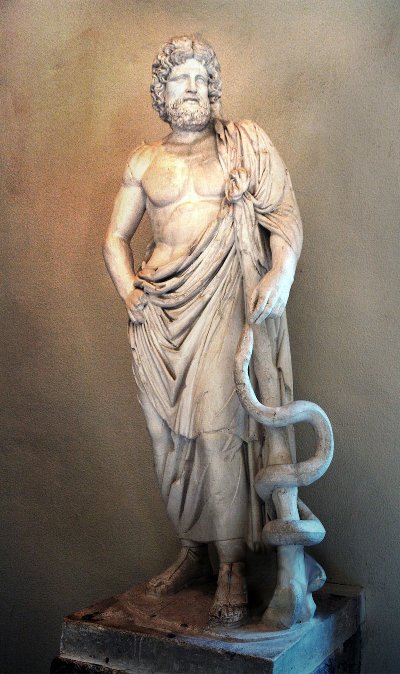 Asclepius/Asklepios with staff & serpent
Asclepius/Asklepios with staff & serpent
Healing by Psychological Suggestion
So was the Asclepius cult successful in healing? And if so, do we know how they did it? According to historian Rick Renner the answer to these questions was, sometimes, and by means of psychological suggestion. The centre at Pergamum was the second largest Asclepeion in the world. If there had not been a measure of success it would not have become as famous as it did. People came from all over the Roman and Greek world to Pergamum for treatment. To be admitted, they had to declare their belief in the god Asclepius and were then promised recovery and restoration. The treatment centre were they lived and slept had to be entered through a long tunnel. Water ran through this tunnel and still runs through the tunnel today. Walking through this long, dark tunnel had a very sedative effect caused by the sound of the water. With this background sound of the water and the darkness impacting the patient's senses, the priests of Asclepius would stand behind the walls and speak through small holes or niches and send subliminal messages by repeating over and over again, 'You're healed! Your healed! You're getting better! You're getting better'. By the time they reached the other end of the tunnel they entered the treatment centre where they lived and slept.
A Well-Known Occult Practice
This is not unlike the subliminal suggestions embedded in music or ambient sounds used today. I don't doubt the priests of Asclepius had this down to a fine art. The one seeking healing would be conscious of the darkness and soothing sound of the flowing water but not hear the hushed words being suggested to them by the hidden priests. Thus their subconscious minds would accept the affirmation and either mobilise natural healing resourses within them and/or, through their expression of faith, invoke the demonic entity masquerading as a god. This is a common, occultic New Age practice even today, a kind of self-hypnosis. So healing may well have happened...but at a spiritual cost. The symbolic snake is now the serpent in Eden and not the bronze serpent of Moses nailed to the staff.
The Asclepeion in Jerusalem - the Pool of Bethesda
Not only was a major asclepaeon present in Pergamum but there was evidently a smaller one in first century Jerusalem too, and it's mentioned in the Bible! Turn with me to John, chapter 5, and we'll understand better an otherwise very peculiar going-on in Roman Jerusalem:
"Now there is in Jerusalem by the sheep gate a pool, which is called in Hebrew Bethesda (Heb. 'House of Mercy' or 'House of the Stream'), having five porticoes. In these lay a multitude of those who were sick, blind, lame, and withered, [waiting for the moving of the waters; for an angel of the LORD went down at certain seasons into the pool and stirred up the water; whoever then first, after the stirring up of the water, stepped in was made well from whatever disease with which he was afflicted.] A man was there who had been ill for thirty-eight years. When Yah'shua (Jesus) saw him lying there, and knew that he had already been a long time in that condition, He said to him, 'Do you wish to get well?' The sick man answered Him, 'Sir, I have no man to put me into the pool when the water is stirred up, but while I am coming, another steps down before me.' Yah'shua (Jesus) said to him, 'Get up, pick up your pallet and walk.' Immediately the man became well, and picked up his pallet and began to walk.
"Now it was the Sabbath on that day. So the Judeans (Jews) were saying to the man who was cured, 'It is the Sabbath, and it is not permissible for you to carry your pallet.' But he answered them, 'He who made me well was the one who said to me, 'Pick up your pallet and walk.'' They asked him, 'Who is the man who said to you, 'Pick up your pallet and walk'?' But the man who was healed did not know who it was, for Yah'shua (Jesus) had slipped away while there was a crowd in that place. Afterward Yah'shua (Jesus) found him in the temple and said to him, 'Behold, you have become well; do not sin anymore, so that nothing worse happens to you.' The man went away, and told the Judeans (Jews) that it was Yah'shua (Jesus) who had made him well. For this reason the Jews were persecuting Yah'shua (Jesus), because He was doing these things on the Sabbath. But He answered them, 'My Father is working until now, and I Myself am working'" (John 5:2-17, NASU).
Luck, Magic and the Survival of the Fittest?
Modern Jews still go there for healing. Now the idea that Yahweh would set-apart a place for healing - a pool - that only had healing properties at "certain seasons" and then only for one person - the one who managed to get into the water first - to my mind and experience doesn't sound at all like the Elohim (God) we know, does it? Its healing elements sound more like luck, magic and the survival of the fittest, like rubbing the belly of a Buddha statue for luck, and not the supernatural activity of Yahweh. Commentators have long been baffled as to why this is in the New Testament at all. In fact, the whole set-up is decidedly cruel because healing was only available to the one who was the most alert and in the right place at the right time for the seasonal "stirring up of the water".
A Scribe Inserts His Own Erroneous Interpretation
This 'explanation', by the way, which reads, "[waiting for the moving of the waters; for an angel of the LORD went down at certain seasons into the pool and stirred up the water; whoever then first, after the stirring up of the water, stepped in was made well from whatever disease with which he was afflicted.]" is a later insertion by a scribe and is not in the oldest manuscripts, which contain different versions of it, like the different endings of the Book of Mark (a clear sign of tampering) which is why you don't find it in modern translations except as footnotes (e.g. NRSV) - the KJV, NKJV and NASB don't even use parentheses, leading to the false impression that this is established text when it is not. And the one I have used today, the New American Standard Updated (NASU) version, correctly puts it in [parentheses]. The Scribe clearly had no idea that this was a pagan shrine and so falsely and ignorantly attributed the practice of the cult to the malak (angel) of Yahweh, misleading millions over the centuries. And, sad to say, scribal commentaries like this do occasionally get accidentally inserted into the Bible text from time to time and it is only the careful work of experts in manuscripts that can sort out this kind of tampering. Sometimes the commentary is accurate and sometimes it is not. Most modern translations helpfully point out these insertions in footnotes.
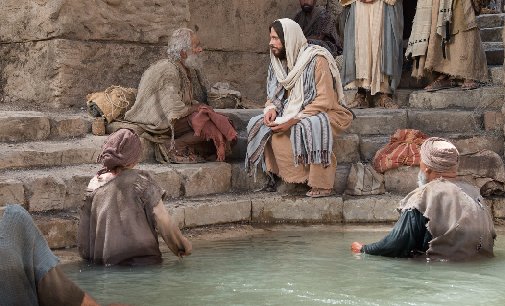 Yah'shua heals a man in the pagan Bethesda asclepeion
Yah'shua heals a man in the pagan Bethesda asclepeion
A Second Option for Healing?
You see, the Pool of Bethesda, which was probably called the Pool of Asclepius in Greek times (remember Judah was very Hellenised, with plenty of cultural compromising going on), but unlike the Pool of Siloam which was attached to the Temple, the Pool of Bethesda was almost certainly a Greek pagan asclepeion even though both obtained their water from the same source. Yah'shua's (Jesus') rebuke of the man he healed, "do not sin anymore, so that nothing worse happens to you" was to warn the man not to make compromises with paganisn again. Whoever that scribe was who inserted his interpretation, he obviously had no idea that this was a pagan healing centre to which the desperate were attracted as a 'second option', as it were, much as many unwise believers today participate in various occult practices for healing and turn to dangerous conventional pharmaceutical medicine as the 'next best thing' when faith doesn't seem to be working for them for healing. Or they turn to the 'health and wealth' Prosperity Gospel making that the centre of their faith. Many in Africa convert because of the false promise of health and wealth and when they don't necessarily get it, they apostacise. In lands where there is much poverty and sickness, they embrace the Gospel only for what they can get out of it, as they suppose.
Nothing Supernatural Going on in Bethesda
This 'healing', when and if it took place at this pagan shrine, was neither the work of "the LORD" (Yahweh) nor was it His 'malak' or 'angel' who did the stirring which is portrayed in the scribe's commentary as a supernatural action. Either non-poisonous serpents were introduced into the water to stir it up (the raised adrenaline levels perhaps causing some form of temporary healing as is often the case in the modern charismatic movement that gets people psyched up - one possible explanation) or (more likely) a sluice was opened and water from a higher reservoir was drained in to keep the lower one - the actual public pool - topped up (another explanation), but either way, there was nothing supernatural or lasting about it. If you'd like to pursue the research work on the Pool of Bethesda in greater depth, then I will leave a link to Dr. Eli Lizorkin-Eyzenberg's excellent study below because what I have said is not mere speculation on my part. Indeed, the Rabbis of the day are known to have been deeply troubled by this particular example of religious compromising with paganism which competed with them and say so in their writings.
From Chaos to Order Through the Word
Yah'shua (Jesus) in the end went and healed the poor man by the power of His spoken Davar (Word). What a contrast to the pagan 'method' of seasonal 'dipping' which didn't in any case work and even then, allegedly, only for the occasional 'lucky one'. Sickness - the symbol of human chaos - was called into order by the power of Yah'shua's (Jesus)' word, just like the pre-creation chaos was once called by Israel's Heavenly King into the order of creation or re-creation in exactly the same way (Gen.1:2). In the account we just read, the royal son of Israel's King, Yah'shua the Messiah (Jesus Christ), comes into the pagan abode (asclepeion) and heals the Judean man without any magical formulas or spells. He does so simply by telling the man to get up and walk. In other words, the Master healed the man the same way Israel's Elohim (God) once ordered the chaotic the world - simply by the power of His spoken Davar (Word).
 As Yahweh created order out of the formless earth in Genesis 1:2, so
As Yahweh created order out of the formless earth in Genesis 1:2, so
He addresses the disorder of sick bodies through supernatural healing
Hygiene and Panacea
I mention all of this for many reasons but especially to make you aware of the fact that Judahites (Jews) and Gentiles alike would have been very aware of this healing cult. Indeed, the names of two of Asclepius' daughters, Hygieia and Panacea, have survived as 'hygiene' and 'panacea' in the English language. Hygieia was the goddess of recouperation and cleanliness (hence another English expression, "cleanliness is next to godliness") and Panacea was the goddess of universal remedy, which is the meaning of the modern English word of the same name too.
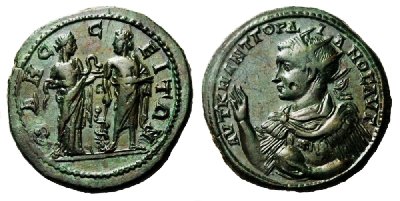 Coin showing Asclepius and his daughter Hygieia
Coin showing Asclepius and his daughter Hygieia
The Bronze Serpent of Moses?
What is particularly interesting is that statues of Asclepius show him holding a staff around which a single snake is wrapped which looks too much like Moses' staff, to which the bronze snake (Nehustan) was affixed, to be a coincidence. You will remember that Moses was commanded by Yahweh to make this on behalf for the rebellious Israelites who were dying of poisonous snake bites:
"Therefore the people came to Moses, and said, 'We have sinned, for we have spoken against Yahweh and against you; pray to Yahweh that He take away the serpents from us.' So Moses prayed for the people. Then Yahweh said to Moses, 'Make a fiery serpent (Nehustan), and set it on a pole; and it shall be that everyone who is bitten, when he looks at it, shall live.' So Moses made a bronze serpent, and put it on a pole; and so it was, if a serpent had bitten anyone, when he looked at the bronze serpent, he lived" (Num.21:7-9, NKJV).
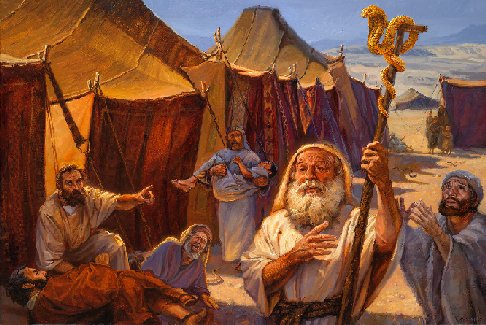
The Greek Legend
Now the big question is, of course, who borrowed the imagery from who? Did the Asclepius cult borrow from the Pentateuch or did the Pentateuch borrow from the Asclepius cult? Or was the similar symbology purely coincidental? The two emblems date back to about the same time in ancient history - the 13th century BC. Around 1280 BC, the city of Troy fell. According to Homer's Illiad, Asclepius was a physician who tended the soldiers wounded on the battefield of Troy. Only later, by the time of Hippocrates (who died in 380 BC), did he become elevated to divine status and was called the son of Apollo. So the divine element in the Greek myth comes way later than the biblical account. The legend grew that Asclepius was such a skilled healer that he was even said to have raised someone from the dead for which Zeus, the king of the Greek gods, killed him. The legend says that Asclepius received his healing powers because the goddess Athena had been given the blood of Medusa - remember, this was the female whose hair was made up of snakes? It looks to me as if the Greeks borrowed from the Hebrews and then adapted the storyline over time.
The Bronze Serpent, the Rod of Aaron and the Cross
The mysterious nechashim sepharim or fiery snakes who bit the rebellious Israelites recall the primordial deception by the nachash or serpent in Eden in Genesis 3:1-6, the temptation to distrust and disobey Yahweh. The serpent's own bitter toxin is death, whether spiritual, physical or both. In Numbers, Yahweh does not take the serpents away, just as temptation remains with us now. Only when someone who was bitten in Moses' day who looked up on the bronze serpent was he saved from death. In the same way, Yahweh did not save Yah'shua (Jesus) from the cross, even though He prayed He might be relieved of that horrid death were it possible (Mt.26:39ff), or remove evil, suffering and death from the world just yet. Rather, we too must go to what the cross represents to be healed of sin, remembering that the cross in and of itself was a symbol of the oppressive and deadly power of the Roman Empire too.
A Double and Apparently Contradictory Symbology
So there's a double and apparently (at surface level) contradictory symbolism in the cross - good and evil - just as there is in the symbolism of the snake nailed to the staff since it represents both the deadly venom of the snake and the means of delivery from it...being nailed to the staff which is a type of the cross of Calvary. We identify with the snake which is our sinning and listening to the serpent just as Christ identified with the sin and became it, overcoming it through His death and resurrection, in our behalf. As we must identify with what happened on the cross, so we identify with the staff (the cross) and the bronze serpent (owning up to our sins) by the same token. The symbolism of both images is deep and profound and lies at the very heart of the doctrine of the atonement. I haven't even touched on the staff or rod of Aaron which was kept in the Ark of the Covenant which he had commanded to be turned into a snake before Pharaoh. That the same rod would later supernaturally blossom as proof of Aaron's divine calling and priesthood in dealing with the rebellion of Korah in the wilderness. In the same way, the serpent-rod of Moses blossoms into the promise that is the cross of Messiah and a Tree of Life to all who will look upon Him for their salvation and deliverance.
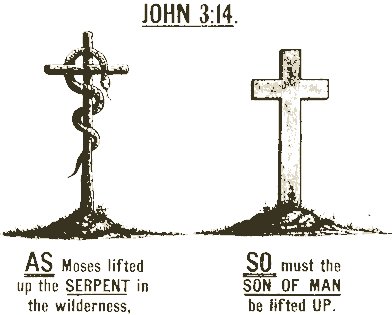
Why a Pagan Pool in Jerusalem Was Allowed
So did Moses borrow from Asclepius or the other way round? That will in large measure depend on your worldview - your faith or your scepticism. And perhaps this symbolic similarity of the rod-and-snake was what made the Pool of Bethesda more 'acceptable' in strictly monotheistic Jerusalem in New Testament times and earlier, but that's just me speculating. No doubt the Maccabees purged the original paganism during their rule (167-37 BC) and it returned when Judea came under Roman control immediately afterwards. It's used on the flag of the United Nations World Health Organisation (WHO).
 Flag of the World Health organisation
Flag of the World Health organisation
Origin of the Caduceus
You will have seen the rod-and-snake symbolism many times in the logo of the caduceus, the ancient Greek or Roman herald's wand that was especially carried by the messenger-god Hermes of Mercury, and is a symbol of medicine still. The wand is crowned by wings and two snakes are coiled around it. Doctors today still take the pagan Hermetic oath to be healers (which is a good one, I might add). Why do we use this double-serpented, winged Hermetic staff as the symbol of medicine and not the earlier Mosaic one which the cult of Asclepius almost certainly borrowed? For the caduceus represents the Greek Hermes and the Roman Mercury, and was anciently a symbol, variously, of trade, eloquence, negociation, alchemy, wisdom, thievery, lying (believe it or not) and the passage to the underworld. Hermes was the Greek god of transitions and boundaries, the protector of traders and herdsmen which the Romans adapted to Mercury, the patron of commerce. The legend goes that Hermes saw two snakes fighting and touched them with his rod to stop the fighting, leading to peace between the two. Since peace is necessary for trade to flourish, that is how it became a symbol of trade.
 The Caduceus - ancient and modern
The Caduceus - ancient and modern
Confusion Caused by American Health Institutions
So how did it become attached to medicine? Well, that was an American doing, they are the ones who introduced the symbol in the late 19th and early 20th century, the first instance being when it was misapplied to the chevrons of US Army hospital stewards in the 1850s. By 1902 it had been added to the uniforms of US Army medical officers. After the First World War, the Navy also began to use the symbol in its Hospital Corps. Even the American Medical Association (AMA) used it for a while. Today, about 59 per cent of American hospitals use the caduceus while 41 per cent use the Rod of Asclepius with commercial institutions using it 76 per cent of the time! I thought you might find that interesting since it's such an important symbol in our own day as well and is linked into the war we are fighting against corrupt medicine and the many hazardous poisons of the pharmceutical industry.
 Seal of the US Public Health Service
Seal of the US Public Health Service
How The Seat if Satan Ended up in Berlin
But let us return to Pergamum and go back to the subject of the Seat of Satan. You can learn more about the fascinating story of how the entire Temple of Pergamum was excavated and transported to Berlin in 1902 in a sermon I gave 12 years ago called Pergamon: the Curse on the German Nation & EU so that I don't have to duplicate that material here today.
Pergamum Builds Temples for Caesar Worship
One especially noteworthy aspect of religion in Pergamum was its worship of political rulers. About 29 BC the city built a magnificent temple for the worship of Caesar Augustus making Pergamum the first city to have a temple dedicated to the imperial cult. During the days of the Emperors Trajan and Severus, two more such temples were constructed there making Pergamum the chief centre of the imperial cult under the early empire [1]. As you know, the purpose of this cult was to politically weld all the various conquered countries of the empire together under a common god - they could each worship their local or national gods, but also must worship the emperor. This same model will be used by the Anti-Messiah or Antichrist at the very and of the Age in order to create a global society - chapters 13-16 and 20 mention the 'image of the beast' many times which we'll be discussing when we eventually get there (Rev.13:4,14; 14:9,1; 15:2; 16:6,20; 20:4).
Revelation 2:12-17
Let's now read today's text and take it on from there:
12 "And to the malak (messenger, angel) of the assembly (congregation, church) in Pergamum (Pergamos) write, 'These things says He who has the sharp two-edged sword: 13 'I know your works, and where you dwell, where Satan's throne is. And you hold fast to My Name, and did not deny My faith even in the days in which Antipas was My faithful martyr, who was killed among you, where Satan dwells. 14 But I have a few things against you, because you have there those who hold the doctrine of Balaam, who taught Balak to put a stumbling block before the children of Israel, to eat things sacrificed to idols, and to commit sexual immorality. 15 Thus you also have those who hold the doctrine of the Nicolaitans (Rev.2:6), which thing I hate. 16 Repent, or else I will come to you quickly and will fight against them with the sword of My mouth. 17 He who has an ear, let him hear what the Ruach (Spirit) says to the assemblies (churches). To him who overcomes I will give some of the hidden manna to eat. And I will give him a white stone, and on the stone a new name written which no one knows except him who receives it." (Rev.2:12-17, NKJV).
The Altar of Zeus and Throne of Satan
Yah'shua (Jesus) addresses the Pergamum assembly from His position as the One bearing a "sharp, double-edged sword" (v.12, KNT), the sword of His mouth. This symbolises His rôle as Judge bringing judgment through His Davar (Word) as it proceeds from His mouth. The congregation has remained true, right there were Satan is enthroned which, as we'll see in a moment, refers specifically to the Altar of Zeus and the showpiece of the imperial cult with its idolatrous temples. It doesn't mean that the throne is there today, and of course it isn't - the place is a ruin and the Altar of Zeus has been removed. Hitler used this artefact as the basis for the design of his Nuremberg ralley centre which tells you something about the heart of nazism.
 Satan's Seat of Throne from pergamum, now in a Berlin museum
Satan's Seat of Throne from pergamum, now in a Berlin museum
A Spiritually Defective Congregation
This congregation is not faultless like the one in Smyrna, though. There is, however, false teaching and immoral practice in the Pergamum congregation, and its members must repent or perish. Paul had permitted believers in extremely immature congregations in Corinth in the 50's to eat idol-food, as long as it did not offend a fellow ex-pagan converts new or weak in the faith and was not consumed in a pagan temple (1 Cor.8:4-13; 10:14-33; Rom.16:6,21) but here Yah'shua (Jesus) through John, expects the matured believers of Pergamum in the 90's (which presumably by extension applied to all seven assemblies in Asia Minor and indeed to all congregations everywhere by then) never to eat meat offered to idols, and forbade the consumption of any meat associated with pagan sacrifices.
Compromising with the Pagan Culture
Whereas some - the "Jezebel" of Thyatira and the "Nicolaitans" of Pergamum and Ephesus - were attempting to secure the participation of believers in social and economic life, now it is clear that the Master requires the assemblies to adopt a separatist disposition as far as meat offered to idols was concerned. The obvious question we must ask ourselves is this: why was Paul apparently more 'liberal' and John more 'conservative'? Do their instructions contradict each other as might appear to be the case on the surface?
The Problems Associated with Non-Participation
To answer those questions we must understand the different circumstances of the 50's to the 90's, something we've already touched upon in this series but which we perhaps now need to probe a little deeper. Again, we see the importance of a little local historical background knowledge. You see, the cities of Asia celebrated and worshipped the imperial family in a number of ways, often with festivals, featuring singing, feasting, and merriment. Those who did not turn up to sing, cheer, eat, and make merry would have been noticeable by their absence, and would eventually have aroused suspicions about their loyalty and devotion to the local gods and to the imperial régime at Rome. One inscription from Pergamom says this:
"Since one should each year make clear display of one's piety and all holy, fitting intentions towards the imperial house, the choir of all Asia, gathering at Pergamum on the most holy birthday of Sebastos Tiberius Caesar god, performs a task that contributes greatly to the glory of Sebastos (= 'Venerable One') in hymning the imperial house and performing sacrifices to the Sebastan gods, and conducting festivals and feasts..." [2].
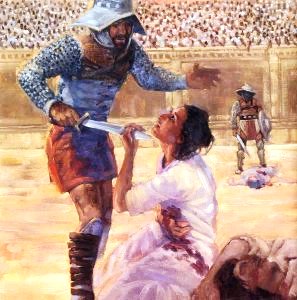 A single grain of incense offering was all that lay between life
A single grain of incense offering was all that lay between life
and death for believers confronted by the totalitarian state
Paul and John Do Not Contradict One Another
Do you see why Paul apparently said one thing and John another? It's not because their instructions were contradictory, as the ultra-messianic anti-Paulists are wont to accuse, nor does it mean that the Bible contradicts itself as the liberals and atheists accuse. Paul is dealing with the issue of whether the act of eating meat offered to idols is going to get you demonised or whether it constitutes a denial of the faith? His answer is, no, to both questions. But, for the sake of weaker brethren whose immature faith might be undermined, the maturer believers are to abstain for their sake. But Yah'shua (Jesus) through John is saying something quite different because here the reference is not to mere pagan worship or issues of demon infestation of the physical meat, but to the imperial cult of emperor-worship at which such meat was consumed once a year. Yes, Rome was pagan in the 50's and still is pagan in the 90's, but in the 50's there was as yet no emperor-worship, or the demand that Christians/Messianics bow the knee to Caesar, proclaiming him 'Lord'. This they could never do because it would mean denying that Messiah alone is 'Master', 'Lord' or 'Sovereign'. To eat this meat is to participate in pagan religious worship which is most emphatically forbidden by Yahweh.
The Issue Resolved
That's the issue here, the context of idol-meat consumption, which was a satanic demand no true believer could ever agree to without becoming an apostate and reprobate denying his salvation. Because this is now the new reality in the 90's, the consumption of meat offered to pagan deities is outright forbidden. What about today, then? Should we eat meat that has been blessed by a Hindu, Moslem, animist or other unbeliever to his particular god? In the context of a religious service, ritual or devotion, then, no, Paul's instruction is to be followed. If the meat was not consumed during the pagan religious devotion, and is afterwards sold, then you may buy and eat it without fear of contamination, provided you pray over it, of course. We eat a lot of Moslem Halal meat here for this reason. But, let's say, the Antichrist is on earth and demands that everyone attend his temple however often, whatever that may be, and worship him, then eating at his table would require the believer to say no, clearly, and result in him being spiritually marked for doom. So you have to carefully examine the cicumstances in which certain instructions are given. Paul and John give us inspired counsel on what to do in two different sets of circumstances. If in doubt, then your default should be to abstain. The 'weaker brother' in one situation becomes the 'strong brother' in another.
 May a Christian/Messianic eat Halal meat?
May a Christian/Messianic eat Halal meat?
Dealing With Totalitarian States Today
The situation in Pergamum for believers was not at all unlike our situation today where the state demands ever more obedience and compliance to its wishes that increasingly conflict with the beliefs and practices of believers. When this happens, you have the beginnings of a contemporary version of the ancient imperial Roman cult of emperor-worship. The state properly exists to protect its citizens, not to demand religious-type worship, however secular, or slavish loyalty to edicts beyond its mandate. It's important that we are clear about what the limits of obedience to the state are because Romans 13:1-7 is often poorly understood and idolatrously abused by believers. Here in Pergamum we have a case study of what Christians/Messianics are to do when a totalitarian state wants its leaders, or itself, to be worshipped. There are boundaries which believers may not cross, even at the pain of death.
Treading Very Carefully With Civil Disobedience
Civil disobedience is a serious matter and should never be entered into lightly. As I speak millions of believers and unbelievers alike are refusing totaliarian vaccine mandates because it is literally a matter of life-and-death. We do have the right to refuse to be killed, however slowly and innocuously is may be being done at first. Such mandates seriously divide society down the middle, as it did in Roman times, for which the politicians and law-makers become accountable. Not since the Nuremberg Trials 75 years ago in the aftermath of the scourge of nazism have we faced a similar situation, where our fundamental and natural right to liberty is being assailed. Christians/Messianics, whilst preferring democracies, have no problems living in totalitarian societies provided they're not forced to cross certain lines. Today the improperly tested 'vaccine' and clearly dangerous and sometimes lethal mandates are the problem. Tomorrow it will almost certainly be Caesar again in the form of the Antichrist, False Prophets, Beast and an idolatrous Image.

Involvement of Believers in the Secular Society
Though the true believers of Pergamum had some serious issues, Caesar-worship wasn't one of them, and Yah'shua (Jesus) commends them. One of their number, Antipas, "the faitful witness", was martyred and was evidently famous in his day and looked up to an an example to emulate. (One of the later Herods was also surnamed 'Herod Antipas' or 'Antipater', a son of Herod the Great, and a devil at that). We can only imagine what life was like for those believers in Pergamum. They must have asked themselves over and over again what they were to do about the cult of Caesar-worship. There must have been many anxious discussions and no doubt a number of theological and philosophical solutions to their problems would have been advanced. Should they take part in normal civic life - which included the festivals of the gods? They would have asked themselves such questions as, 'What do I need to do - the bare minimum - in order to get by in Pergamum society without getting fully involved?'
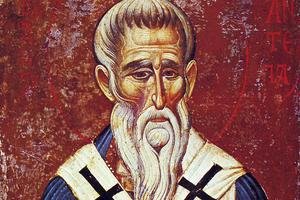 Antipas of Pergamum, the faithful witness
Antipas of Pergamum, the faithful witness
Matters of Conscience
They weren't the first to ask. Every generation all over the world asks these questions, a reason why Paul was inspired to write 1 Corinthians 8 and Romans 14. He was very careful in his answers. Indeed, his advice was very nuanced, that's to say, contained many shades of meaning as he had to be careful what he wrote as word of his letters would eventually get back to the authorities. In other words, there were grey areas and it would be up to the individual conscience to make personal and family decisions about these particular situations, there sometimes being neither 'right' nor 'wrong' responses, with various members of the messianic community (church) undoubtedly making contrary choices. We have had to face numerous such choices ourselves over the years. But there was, Paul said, most definitely a line drawn in the metaphorical sand: there was to be no compromise with pagan temples and the pagan cult of Caesar-worship, but flexibility on food that had been offered to idols though not, as some have false accused him of doing, flexibility about whether to eat kosher or not. Yahweh's kosher laws tell us what food is and isn't. Thus chicken is food but pork is not, and that can never change.
Society, Liberalism and Cultural Assimilation
Some of the believers in Pergamum seem to have adopted a liberal approach and considered cultural assimilation to be in order. They didn't want to stand out or be seen to be 'different' - they were concerned about their 'image' in society and wanted to be liked and accepted by the pagans. We are, of course, to live in peace with our non-believing neighbours, and indeed we are commanded to so do. There is no reason why we cannot live in mutual respect of one another's beliefs and establish working social boundaries. The problems come when society expects absolute uniformity and conformity, usually driven by the state which wants to be able to control people more easily. I have friends from all sorts of belief systems and worldviews and we remain friends because we know one another's boundaries, and respect them, which is the mature way that diverse people learn to get along with one another. I personally learned that skill-set growing up in multi-ethnic and multi-cultural Malaysia where it was the natural and common-sense thing to do. But unfortunately not everybody is like that and when society as a whole starts becoming intolerant and demanding absolute cultural conformity, then the problems start. Then we start to stand out and people look down on us with contempt for not being like them in every detail.
Balak & Baalam
One area where believers and modernists have a problem is in the area of sexual morality. The pagans of Pergamum and of the age in general were pretty loose and immoral, as indeed they have become again today in the post-Christian West. Indeed the parallels are strikingly similar. Make no mistake, for those who compromise with pagan sexual immorality, Yah'shua (Jesus) has stern words of rebuke, underminding the liberal claim that He was tolerant of any and every sexual orientation and behaviour. In today's passage He reminds His readers that this was exactly the same mistake that the Israelites committed when King Balak of Moab hired the prophet Balaam to curse them. And though Balaam was a pagan, he found that he could not curse Israel and to that extent was a true navi (prophet). But he still greedily wanted Balak's promised reward, and so he encouraged the king to use a different tactic. Where direct spiritual attack (the curse) had failed, more subtle temptation might work, and did. And as so often is the case, the best temptation would be sexual.
The Honey-Trap, Sexual Morality and the Eternal Pattern of Marriage
And so, in an ancient version of the 'honey-trap' beloved by spy novels and in actual spying, Moabite women were sent to entice the Israelite men and by this means, as later with Solomon, were drawn into idolatry, worshipping gods other than Yahweh. So Balak and Balaam succeeded. It's why we are strictly commanded not to marry unbelievers (2 Cor.6:14). Well, the same tactic evidently works just as well today. You see, sexual morality isn't just a matter of a few ancient rules clung to by some rather conservative persons while the rest of society has 'moved on' or 'progressed'. It is the original calling of the Creator Himself for men and women to be faithful to one another in marriage between dedicated believers because marriage is supposed to represent the complimentarity of heaven and earth. The whole Bible is saturated in marriage language. And indeed, as you will see, this is the great theme which finally emerges at the end of the Book of Revelation and the Bible as a whole, the same way it began with Adam and Eve, finally ending with Messiah the Bridegroom as the the overcoming Messianic Community (Church) or Bride.
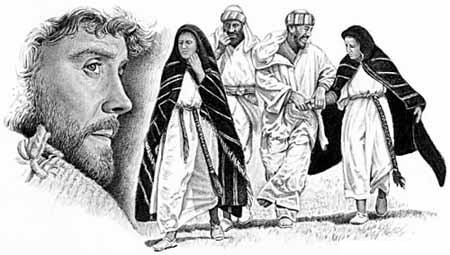 Balaam entices Israelite men with the honey-trap of Moabite women
Balaam entices Israelite men with the honey-trap of Moabite women
The Toxic Mixture
Married love is a signpost to the faithfulness of the Creator to His creation. The reason sexual immorality is so often linked to idolatry, as here in this letter to Pergamum, is because such behaviour points to different gods - the gods of blood and soil, or race and power, and the demonic agenda. It's a toxic mixture and the believer has no business getting involved with it, as Paul himself warned in 1 Corinthians 10:
"...we should not lust after evil things as they (the Israelites) also lusted. And do not become idolaters as were some of them. As it is written, 'The people sat down to eat and drink, and rose up to play.' Nor let us commit sexual immorality, as some of them did, and in one day twenty-three thousand fell; nor let us tempt Christ, as some of them also tempted, and were destroyed by serpents; nor complain, as some of them also complained, and were destroyed by the destroyer" (1 Cor.10:6-11, NKJV).
Learning to Say 'No'
I think it highly likely that the Nicolaitans were a small group within two of the seven Johannine congregations, of which Pergamum was one, teaching something very akin to the "teaching of Balaam", namely, that they were promoting the same sexual immorality that was the norm of the pagan culture around them. There are those who think that the names 'Balaam' and 'Nicolas' may have similar meanings, which may or may not be so. Whatever the explanation is, the problem in Pergamumn was that much the congregation there had lost its cutting edge because of its inability to say 'no' to the surrounding culture and its moral norms. As the earliest believers discovered in Acts, the messianic community (church) always has to be able to say, "We ought to obey Elohim (God) rather than men" (Acts 5:29, NKJV) or "human authorities" (KNT), even if the 'authoritities' in question, not the official magistrates (though the magistrates, too, may pose a threat if the believers refuse to join in with the state religion) but simply the insidious pressure of people saying 'but this is what everybody does.
The Sword of State or the Double-Edged Sword of Yah'shua?
Yah'shua's (Jesus') response is crystal clear. The Roman governor may wield the sword but Yah'shua (Jesus) has the sharp two-edged sword coming out of His mouth (vv.12,16; cp. 1:16) and He is the final and absolute Judge and Authority. Because His Davar (Word) will cut throughn the half-hearted spirituality that is happy facing both ways at once with one foot in the Kingdom and the other in the world. You can't be in both - you have to choose one or the other or you become a "double-minded man...unstable in all [your] ways" (Jas.1:8, NIV)...and the unstable, as Peter reminds us, are vulnerable to seduction by the Enemy (2 Pet.2:14, NIV).
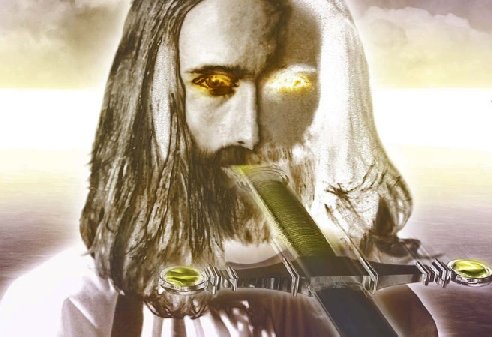 "I...will fight against them with the sword of my mouth" (Rev.2:16, KNT)
"I...will fight against them with the sword of my mouth" (Rev.2:16, KNT)
Like the Ancient Israelites
As in all the other six letters, there is a promise to Pergamum even if it is a little obscure. Recorded in the writings of many of the early believers is the idea that these little congregations in Asia Minor, and indeed throughout the Roman world, are like the Israelites in the wilderness, which is the setting of the story of Balaam, isn't it? It's the same setting that Paul uses for his similar warnings in 1 Corinthians 10 which we looked briefly at earlier. On that wilderness journey, Yahweh fed His people with "manna", bread that dropped down from heaven. And here, in this letter to the Pergamumites, Yah'shua (Jesus) promises to do the same. The place where you are currently living may be spiritually starving you but, says He, I will give you 'secret manna', hidden nourishment, to meet your every need.
A Pointer to the Master's Supper
Throughout the centuries many believers have clung on to this promise as they find themselves spiritually hungry in an alien environment. And there are many who have also seen in this reference to hidden manna a pointer to he Sacrament of the Saviour's body and blood, to the Master's (Lord's) Supper, again with parallels in 1 Corinthians 10. Remember what He said:
"Moreover, brethren, I do not want you to be unaware that all our fathers were under the cloud, all passed through the sea, all were baptised into Moses in the cloud and in the sea, all ate the same spiritual food, and all drank the same spiritual drink. For they drank of that spiritual Rock that followed them, and that Rock was Christ... Therefore, my beloved, flee from idolatry. I speak as to wise men; judge for yourselves what I say. The cup of blessing which we bless, is it not the communion of the blood of Christ? The bread which we break, is it not the communion of the body of Christ? For we, though many, are one bread and one body; for we all partake of that one bread" (1 Cor.10:1-4,14-17, NKJV).
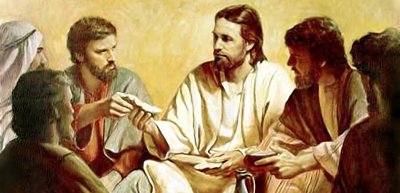
The Mysterious White Stone
Finally, there is a most unusual promise of a white stone with a new name written on it. The 'white stone' is a new concept but a 'new name' is not. What could this name be? Is it a unique name for every believer or is it something else? The navi (prophet) Isaiah is the only writer who speaks of such a 'new name':
"For Zion's sake I will not keep silent,
for Jerusalem's sake I will not remain quiet,
till her righteousness shines out like the dawn,
her salvation like a blazing torch.
The nations will see your righteousness,
and all kings your glory;
you will be called by a new name
that the mouth of Yahweh will bestow.
You will be a crown of splendour in Yahweh's hand,
a royal diadem in the hand of your Elohim (God).
No longer will they call you Deserted,
or name your land Desolate.
But you will be called Hephzibah ('my delight'),
and your land Beulah ('married');
for Yahweh will take delight in you,
and your land will be married.
As a young man marries a maiden,
so will your sons marry you;
as a bridegroom rejoices over his bride,
so will your Elohim (God) rejoice over you" (Isa.62:1-5, NIV).

The New Name
Could the 'new name' be Hephzibah, 'My Delight'? Certainly that could be a part of it in the broader, communitarian sense. But here Yah'shua (Jesus) is being much more personal, for He says inscribed on the stone will be "a new name...which nobody knows except the one who receives it" (v.17, KNT). So, no, it cannot specifically be Hephzibah which is a collective or communal name like 'Zion' describing many people simultaneously. Nor can it be the Name of Yah'shua the Messiah (Jesus Christ) which is hardly a secret Name unknown to any but each convert, as opposed to the 'old names' of the local and imperial gods and goddesses. Nor can this be the Israelite tribal name of the bearer of the stone because that will hardly be unique to himself. Yes, the Names of the Twelve Tribes were inscribed on the clothing of the Cohen Gadol (High Priest) and, yes, Yah'shua (Jesus) is that Eternal Cohen Gadol or High Priest, the one True Israelite into whom we are grafted by faith and by covenant (Mal.2:10,14). All of these things are true. But this message is very personal, as between two lovers - as between a husband and a wife - an intimate name utterly unique to the bridal couple. He has, for the faithful talmidim (disciples) and overcomers, to each who 'conquers' - the bride - a new name - for each of us. But why is this name written specifically on a white stone?
The Black Buildings of Pergamum
Here a knowledge of Pergamum's history comes to our aid once again. You see, Pergamum's great buildings were made of a black local stone. That probably surprises you because when you think of the magnificent buildings of ancient Rome and Greece you automatically think of white stone, whether it be the magnificent Acropolis in Athens or the Colloseum in Rome...at least I do. So the buildings of Pergamum were black making it somewhat distinct from other cities whose buildings were white as they still are in modern Greece and in the Aegean generally as this better reflects the sunlight and keeps the buildings cool. When people wanted to put up inscriptions in Pergamum, they got hold of white marble on which to carve them. These white marble slabs were then fixed to the black buildings, where they stood out all the more clearly.
 The black limestone which was used to construct Pergamum's buildings
The black limestone which was used to construct Pergamum's buildings
Guest Invitation Stones
But that's not all - and this may tie in somehow with the 'hidden manna' - there was a custom of guests at a feast in Pergamum being given a stone with their name on it as a ticket of admission! So in hearing this letter read out to them, the local qodeshim (saints, set-apart ones) at Pergamum whould have immediately made these associations because they were recognisable things in their culture, thus making the words of Yah'shua (Jesus) written personally to them all the more memorable. And when, in listening to the whole of John's Apocalypse, they came to chapter 19 that speaks of 'the marriage feast or wedding supper of the Lamb' (Rev.19:7,9) the Pergamumites in particular would have remembered their own feasts and the white admission stones. So you see, it all ties neatly together.
Summary
In summary, then, the challenge to the Pergamumites and all of us reading this letter is to strictly avoid the false intimacy of sexual promiscuity and in compromising with the world for then we are made an irresistable offer of a genuine spiritual union with Yah'shua (Jesus) Himself, in part now (if we are habitually walking faithfully) but in the fullness at that last great Sukkot or Feast of Tabernacles which was, and currently remains, an unfulfilled type of the Marriage Feast of the Lamb. Let us be like Antipas, if we are ever called upon to make the final sacrifice, by refusing to bow down to the gods of empire, be they Roman or globalist.
Conclusion
I hope these thoughts have been some small blessing to you today and that they will encourage you to dig even deeper and to pursue Yah'shua (Jesus) all the more ardently! Until next week when we shall turn our attention to Thyatira! Yahweh bless you all. Amen.
Continued in Part 13
Endnotes
[1] Encylopædia Britannica, 11th edition, Vol.21, p.143
[2] S.R.F.Price, Rituals and Power: The Roman Inmperial Cult in Asia Minor (Cambridge University Press, Cambridge: 1984), p.105
Acknowledgements
[1] David Abulafia, The Great Sea: A Human History of the Mediterranean (Allen Lane, London: 2011), part 5, chapter IV, section I, A tale of Four and a Half Cities, 1918-1945
[2] Tom Wright, Revelation for Everyone (SPCK, London: 2011)
[3] N.T.Wright & Michael F.Bird, The New Testament in Its World: An Introduction to the History, Literature, and Theology of the First Christians (Zondervan Academic, Grand Rapids, Michigan: 2019)
[4] Dr.Eli Lizorkin-Eyzenberg, The Pool Of Bethesda As A Healing Center Of Asclepius
[5] Derek P.Gilbert, The Great Deception: Satan's Psyops from Eden to Armageddon (Defender Publishing Crane, Missouri: 2017)
[6] Bruce R.Metzger & Bart D.Ehrman, The Text of the New Testament: Its Transmission, Corruption and Restoration (OUP, Oxford: 2005)
Further Reading
[1] Antipas: He Died at Satan's Throne (Rev.2:13)
[2] Pergamum: The Curse on the German Nation & EU
 Click the image for the whole Series
Click the image for the whole Series

 V325
V325
|


